
Bartolomé Esteban Murillo was a Spanish Baroque painter. Although he is best known for his religious works, Murillo also produced a considerable number of paintings of contemporary women and children. These lively realistic portraits of flower girls, street urchins, and beggars constitute an extensive and appealing record of the everyday life of his times. He also painted two self-portraits, one in the Frick Collection portraying him in his 30s, and one in London's National Gallery portraying him about 20 years later. In 2017–18, the two museums held an exhibition of them.

Pedro de Orrente was a Spanish painter of the early Baroque period who became one of the first artists in that part of Spain to paint in a Naturalistic style.

Pedro de Campolargo was a Flemish painter and engraver, who was active during the Baroque period and formed part of a large group of Flemish artists mostly from Antwerp who were active in Seville in the second half of the 17th century.
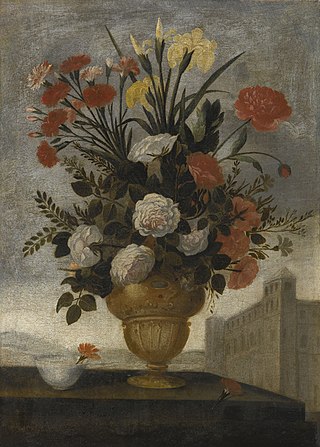
Pedro de Camprobín Passano was a Spanish Baroque painter who specialized in still-lifes; primarily flowers.
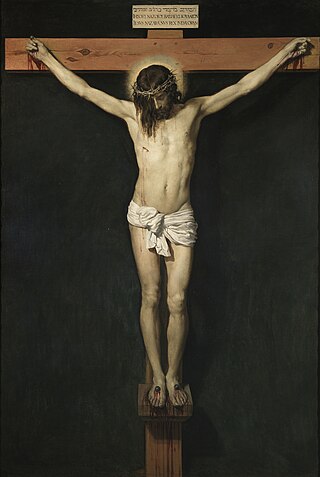
Christ Crucified is a 1632 painting by Diego Velázquez depicting the Crucifixion of Jesus. The work, painted in oil on canvas, measures 249 × 170 cm and is owned by the Museo del Prado.

Doña Antonia de Ipeñarrieta y Galdós and Her Son Don Luis is a 1634 portrait by Diego Velázquez, now in the Prado Museum. Doña Antonia and her son Luis are shown standing, captured in an elegant melancholy. The woman uses the chair to support herself, to emphasize her social status in the Court, where she had the right to sit. According to different studies of the canvas, it is believed that the child's figure could have been added afterwards.

The Jester Barbarroja is an oil on canvas portrait by Diego Velázquez of Cristóbal de Castañeda y Pernia, nicknamed Barbarroja in his role as a jester at the court of Philip IV of Spain from 1633 to 1649. The painting is now in the Museo del Prado. It was in the Palacio del Buen Retiro in Madrid in 1701 and from 1816 to 1827 it was in the Real Academia de Bellas Artes de San Fernando.
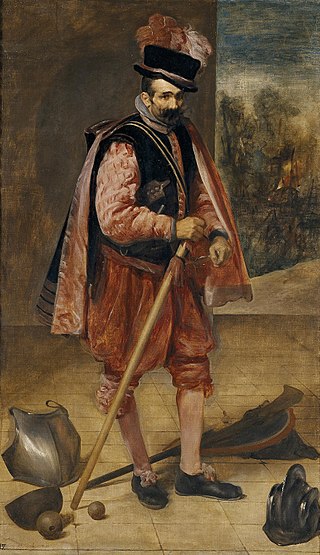
The Jester Named Don John of Austria is a portrait by Velázquez, now in the Museo del Prado in Madrid. Its subject was a jester or bufón at the court of Philip IV of Spain from 1624 to 1654 who appeared in court comedies in front of important court figures. The subject's real name is unknown, but he came to be nicknamed after John of Austria, the son of Charles V, well known for his victory at Lepanto. He is shown dressed in a general's cloak and black doublet, is surrounded by abandoned helmets, armour and weapons, and with a fragment of a battle-scene of Lepanto in the background.
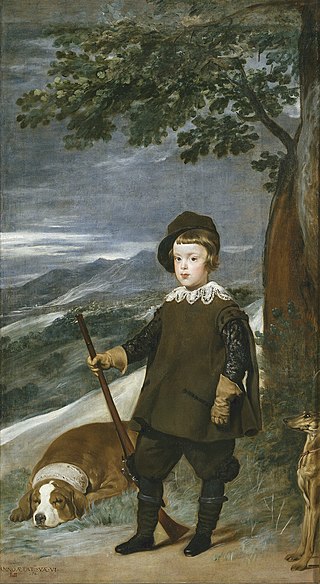
Prince Balthasar Charles as a Hunter is a 1635 portrait of Balthasar Charles, Prince of Asturias by Diego Velázquez. It is now held at the Museo del Prado.

Francisco Antolínez de Sarabia (1645–1700) was a historical and landscape painter who studied in the school of Murillo, whose style and manner of colouring he followed.
Andres Rossi was a Spanish artist. He worked as a painter, draughtsman, print maker, sculptor and writer in Madrid and Seville.

The Immaculate Conception of Los Venerables or The Immaculate Conception of Soult is an oil painting by the Spanish artist Bartolomé Esteban Murillo. It was painted c. 1678 and measures 274 cm × 190 cm. Looted by Marshal Jean-de-Dieu Soult in 1813 and taken to France, it was bought by the Louvre in 1852. It has been held by the Museo del Prado, Madrid, since 1941.
Francisco Javier Sánchez Cantón (1891–1971) was a Spanish art historian, who from 1960 to 1968 was Director of the Museo del Prado.

José García Ramos was a Spanish painter and illustrator; known primarily for his costumbrista scenes.
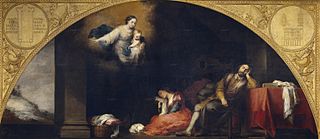
The Patrician's Dream or The Foundation of Santa Maria Maggiore in Rome I: The Dream of Patrician John is a 1665 oil on canvas painting by Bartolome Murillo. It has been in the Museo del Prado since 1901.

Children Eating Grapes and a Melon is a 1645-1650 oil on canvas painting by Bartolomé Esteban Murillo, now in room XIII of the Alte Pinakothek in Munich. Along with religious works, realistic and naturalistic genre scenes like this form one of the most oft-repeated themes in the artist's oeuvre, often centred on children, as also seen in Children Playing Dice and The Young Beggar.

Our Lady of the Rosary is a 1650-1655 oil on canvas painting of Our Lady of the Rosary by Bartolomé Esteban Murillo, previously in the El Escorial Monastery and Palacio Real de Madrid and now in the Museo del Prado in Madrid.

Saint Elizabeth of Hungary Curing the Sick is an oil on canvas painting by Bartolomé Esteban Murillo, created in 1672, commissioned by Miguel de Mañara for the church of San Jorge in the Hospital de la Hermandad de la Caridad in Seville, where it still hangs in its original position. Showing Elizabeth of Hungary pouring water on the head of a child affected by tinea capitis, it forms part of a group of Murillo works in the church on the works of pity and the exercise of charity.

Christ on the Cross may refer to one of four oil on canvas paintings by the Spanish Baroque artist Bartolomé Esteban Murillo:

















